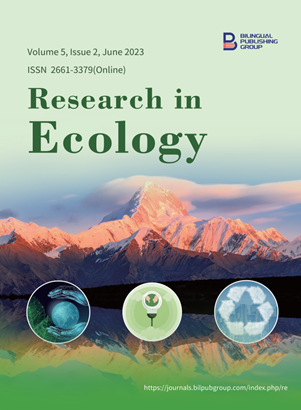
A Proposed Method for Evaluating Management Feasibility When Determining Weed Control Priorities after Major Fires and Floods
DOI:
https://doi.org/10.30564/re.v5i2.5791Abstract
Major fires and floods have enormous impacts on natural ecosystems and are predicted to increase in frequency with global warming. Land managers need to make decisions on the prioritisation of weeds for control in post-disturbance landscapes, but little is available in the way of guidance to support timely decision making. Semi-quantitative models (e.g., scoring systems) have been employed routinely in weed risk assessment, which considers the potential impacts posed by weeds, as well as the likelihood of these impacts being realised. Some progress has been made in the development of similar models addressing the topic of weed risk management. Under conditions prevailing after major disturbances, changes (both positive and negative) can be expected in the multiple factors that determine weed management feasibility, relative to pre-disturbance conditions. A semi-quantitative model is proposed that is based on the key factors that contribute to weed management feasibility in post-disturbance environments, along with annotated modules that could be used by land managers in both post-fire and post-flood situations. The fundamental challenge for weed management in these scenarios lies in the identification of differences between weeds and native species in relation to (1) patterns of seedling emergence; and (2) detectability relative to the growth stage. These two factors will determine the timing of control actions that are designed to address the trade-off between weed control and off-target damage during the period when both types of plants are recovering from a major disturbance event. The model is intuitively sound, but field testing is required to determine both its practical value and any necessary improvement.
Keywords:
Maintenance control; Natural ecosystems; Semi-quantitative models; Weed risk managementReferences
[1] Hobbs, R.J., Humphries, S.E., 1995. An integrated approach to the ecology and management of plant invasions. Conservation Biology. 9(4), 761-770. DOI: https://doi.org/10.1046/j.1523-1739.1995.09040761.x
[2] Abram, N.J., Henley, B.J., Sen Gupta, A., et al., 2021. Connections of climate change and variability to large and extreme forest fires in southeast Australia. Communications Earth & Environment. 2(1), 8. DOI: https://doi.org/10.1038/s43247-020-00065-8
[3] Kumar, A., Nagar, S., Anand, S., 2021. Climate change and existential threats. Global climate change. Elsevier: Amsterdam. pp. 1-31.
[4] Angra, D., Sapountzaki, K., 2022. Climate change affecting forest fire and flood risk—Facts, predictions, and perceptions in central and south Greece. Sustainability. 14(20), 13395. DOI: https://doi.org/10.3390/su142013395
[5] Zimmer, H., Cheal, D., Cross, E., 2012. Post-fire Weeds Triage Manual: Black Saturday Victoria 2009—Natural Values Fire Recovery Program [Internet] [cited 2023 Jun 17]. Available from: https://www.ari.vic.gov.au/__data/assets/pdf_file/0023/34970/VBRRA-report-23-web.pdf
[6] Panetta, F.D., Grigg, A., 2021. A weed risk analytical screen to assist in the prioritisation of an invasive flora for containment. NeoBiota. 66, 95-116. DOI: https://doi.org/10.3897/neobiota.66.67769
[7] Booy, O., Mill, A.C., Roy, H.E., et al., 2017. Risk management to prioritise the eradication of new and emerging invasive non-native species. Biological Invasions. 19, 2401-2417. DOI: https://doi.org/10.1007/s10530-017-1451-z
[8] Vanderhoeven, S., Branquart, E., Casaer, J., et al., 2017. Beyond protocols: Improving the reliability of expert-based risk analysis underpinning invasive species policies. Biological Invasions. 19, 2507-2517. DOI: https://doi.org/10.1007/s10530-017-1434-0
[9] Gordon, D.R., Flory, S.L., Lieurance, D., et al., 2016. Weed risk assessments are an effective component of invasion risk management. Invasive Plant Science and Management. 9(1), 81-83. DOI: https://doi.org/10.1614/IPSM-D-15-00053.1
[10] Virtue, J.G., Groves, R.H., Panetta, F.D., 2001. Towards a system to determine the national significance of weeds in Australia. Weed risk assessment. CSIRO Publishing: Melbourne. pp. 124-150.
[11] Wilson, J.R., Panetta, F.D., Lindgren, C.J., 2016. Detecting and responding to alien plant incursions. Cambridge University Press: Cambridge. pp. 1-265.
[12] Panetta, F.D., Cacho, O.J., 2012. Beyond fecundity control: Which weeds are most containable? Journal of Applied Ecology. 49(2), 311-321. DOI: https://doi.org/10.1111/j.1365-2664.2011.02105.x
[13] Richardson, D.M., Pyšek, P., Rejmanek, M., et al., 2000. Naturalization and invasion of alien plants: Concepts and definitions. Diversity and Distributions. 6(2), 93-107. DOI: https://doi.org/10.1046/j.1472-4642.2000.00083.x
[14] Panetta, F.D., Gooden, B., 2017. Managing for biodiversity: Impact and action thresholds for invasive plants in natural ecosystems. NeoBiota. 34, 53-66. DOI: https://doi.org/10.3897/neobiota.34.11821
[15] Virtue, J., Cunningham, D., Hanson, C., et al., 2006. National Post-border Weed Risk Management Protocol [Internet] [cited 2023 Jun 17]. Available from: https://www.saiglobal.com/pdftemp/previews/osh/as/misc/handbook/hb294-2006.pdf
[16] Virtue, J.G., 2010. South Australia’s weed risk management system. Plant Protection Quarterly. 25(2), 90-94.
[17] Johnson, S., 2009. New South Wales Weed Risk Management System [Internet] [cited 2023 Jun 17]. Available from: https://www.researchgate.net/publication/275347123_New_South_Wales_Weed_Risk_Management_System_Instruction_Book
[18] Panetta, F.D., 2007. Evaluation of weed eradication programs: Containment and extirpation. Diversity and Distributions. 13(1), 33-41. DOI: https://doi.org/10.1111/j.1472-4642.2012.00932.x
[19] Hiebert, R.D., 1997. Prioritizing invasive plants and planning for management. Assessment and management of plant invasions. Springer: New York. pp. 195-212.
[20] Gooden, B., French, K., Turner, P.J., et al., 2009. Impact threshold for an alien plant invader, Lantana camara L., on native plant communities. Biological Conservation. 142(11), 2631-2641. DOI: https://doi.org/10.1016/j.biocon.2009.06.012
Downloads
How to Cite
Issue
Article Type
License
Copyright © 2023 The author(s)

This is an open access article under the Creative Commons Attribution-NonCommercial 4.0 International (CC BY-NC 4.0) License.




 F. Dane Panetta
F. Dane Panetta






